US crypto legislation could bring clarity and derivatives boost
Key Takeaways
- Proposed US crypto law aims to boost protection and growth
- Clearer regulatory mandate for SEC and CFTC in digital assets
- A boost for crypto derivatives, but still a work in progress
US lawmakers hope to establish a regulatory framework by the end of the year that will protect consumers and keep the US at the forefront of digital assets.
The Financial Innovation and Technology for the 21st Century Act (or FIT21) was passed in the House in May (despite White House opposition) and is awaiting Senate approval. The bipartisan initiative aims to reduce uncertainty, especially in crypto derivatives, to encourage institutional investment.
Patrick McHenry, the chairman of the House Financial Services Committee, said FIT21 “ensures America leads the financial system of the future and remains a hub for technological innovation.”
Clarifying regulatory roles
It clarifies, among other things, the roles of the Commodity Futures Trading Commission (CFTC) and the Securities Exchange Commission (SEC) in derivatives and securities, two areas where crypto (and the watchdogs) often overlap, generating confusion for issuers and investors. Ripple Labs’ drawn-out legal battle with the SEC about its XRP token (security or commodity?) is a case in point.
Under FIT21, the SEC would oversee digital assets classified as securities and the CFTC would regulate those defined as commodities and derivatives. This ‘could significantly alleviate the regulatory ambiguities that have clouded the industry’s growth,’ Forbes wrote.
It is not to everyone’s liking, though. One crypto-focused lawyer said in May that the dual regulatory regime under FIT21 would still give the SEC “huge power.”
FIT21’s backers aim to bring the US regulatory framework up to par with the European Union, Japan, and Singapore. Regulators globally continue to tackle the volatility and risks associated with digital assets, including market manipulation, cyber-attacks, and money laundering.
Let’s look at some of the regulations adopted around the globe.
Crypto regulation in the EU
The EU’s Markets in Crypto-Assets Regulation (MiCA) creates a comprehensive regulatory framework. It mandates that companies obtain licenses for issuing or trading crypto-assets and enforces strict transparency and consumer protection measures. The goal is to enhance market integrity, reduce risks of manipulation and fraud, and bolster investor confidence.
Other EU regulations, including anti-money laundering (AML) rules, tax reporting, bank capital requirements, and a distributed ledger technology (DLT) pilot regime, further shape the crypto landscape.
Although in its early stages, MiCA is expected to boost institutional participation, liquidity, stability, innovation, and competitiveness.
However, the regulations pose challenges, particularly for stablecoin issuers, startups and smaller firms, which might struggle to meet the stringent transparency and reporting requirements. According to industry experts, this could drive some out of the EU market altogether.
Crypto regulation from Japan to Switzerland
Japan’s Payment Services Act (PSA) and Financial Instruments and Exchange Act (FIEA), in effect since May 2020, require crypto exchanges to adhere to strict anti-money laundering and consumer protection rules, with a focus on crypto-asset derivatives to enhance market transparency and stability. While Japanese crypto regulations have set the standard for the rest of the world, high compliance costs may force smaller firms to partner with larger companies to sustain their brand and reach a wider global audience.
Singapore’s Payment Services Act (PSA), which has been in effect since January 2020, regulates crypto exchanges and digital payment token services. The Monetary Authority of Singapore enforces anti-money laundering and counter-terrorism rules, fostering a secure and transparent crypto environment that supports fintech innovation and derivatives trading. While regulatory costs and requirements are challenges, the PSA establishes Singapore as a global fintech hub and boosts confidence in the crypto and derivatives markets.
South Korea’s Virtual Asset User Protection Act (July 2023) requires exchanges to keep 80% of user funds in cold storage and maintain reserves matching customer deposits. Switzerland issued new guidance for stablecoins, focusing on anti-money laundering (AML) risks and the need for strong regulatory oversight. Hong Kong is developing guidelines for stablecoin issuers, covering licensing and supervision, as it prepares a comprehensive regulatory framework. In Qatar, the DLT Guideline promotes fintech innovation by encouraging the use of DLT to improve efficiency and security in the financial sector.
In short, regulations are evolving as global efforts to balance innovation in digital assets gather momentum.
Crypto regulation shaping markets and boosting derivatives
Matthew Sigel, head of digital assets research at VanEck, predicts rapid growth for the digital asset derivatives market, especially Bitcoin futures. Equity and commodity derivatives are significantly larger than Bitcoin’s in relation to their underlying markets, indicating substantial growth in crypto derivatives.
The SEC’s recent authorization of options trading for BlackRock’s iShares Bitcoin Trust (IBIT) is widely expected to stimulate growth. Being one of the most liquid ETFs in the United States, IBIT’s options trading is expected to draw additional liquidity and institutional investors.
The momentum in crypto derivatives cannot be decoupled from the advance of asset tokenization. The adoption of DLT allows for more fractional ownership, making high-value assets more accessible to a wider pool of investors and bringing more collateral into play. As we wrote in April, this is particularly impactful in markets like derivatives. JPMorgan’s in-house blockchain-based Tokenized Collateral Network (TCN) is an example of these advancements, allowing investors to utilize assets as collateral.
Equally, tokenization and DLT can facilitate greater efficiency, particularly in certain post-trade processes, by allowing cash and securities to be transferred instantaneously 24/7, eliminating the risks that can arise over weekends and holidays.
As global regulatory standards become more aligned, the adoption of derivatives and blockchain-based financial products will accelerate. As in any area of the financial markets, challenges exist. In the European stablecoin market, for instance, new regulations and high compliance costs might push some firms to attempt “regulatory arbitrage” by relocating to less regulated areas or use loopholes by offering services in Europe without officially setting up there.
Nevertheless, without clear oversight internationally, users are exposed to unfair price swings, investor losses, and criminal activities. As a World Economic Forum 2023 White Paper says, cross-border coordination is “not just desirable but necessary”.
And whatever the outcome of FIT21 in the US – for there’s no guarantee what its final form will take, given the 5 November presidential election, and opposition from SEC Chairman Gary Gensler and Joe Biden – crypto is in the ascendant.
Don't miss out
Subscribe to our blog to stay up to date on industry trends and technology innovations.


